
Testing of dogs: Locus A (Alleles Ay, aw, at, a)
Related tests
- Combination Belgian Shepherd - Groenendael CACA + CJM + DM (SOD1A) + SDCA1 + SDCA2 + allele KB + locus A
- Combination Belgian Shepherd - Tervueren CACA + CJM + DM (SOD1A) + SDCA1 + SDCA2 + locus A
- Combination Puli DM (SOD1A) + PLL + PRA-prcd + vWDI + BBS4 + Locus A + Locus E + Locus K, KB allele only
- Combination Shiba GM1 + GM2 + Locus A + Locus E
- Combination coat colors + coat length in dogs Loci A + B + D + E + I + KB and coat length M1, M3, M4, M5
- Combination coat colors in Geat Dane Loci A + D + E + EM + I + KB + harlequin
- Combination coat colors in dogs Loci A + B + D + E + I + KB
- Combination coat colors in dogs, extended Loci A + B + D (d1, d2, d3) + E (EM, eG,eH, e1, e2, e3) + I + KB
- Locus A complete test (alleles Ay, Ays, aw at, asa, a) Agouti locus
A Locus (Agouti locus)
For an overview of dog coat color hierarchy continue to the article Introduction into coat color in dogs.
ASIP gene (Agouti signal peptide)
This gene was mapped to dog chromosome 24. There are described 4 alleles having the subsequent hierarchy: ay >aw> at> a. The alleles ay, aw, at are jointly designated A-alleles (Agouti) and a-allele (non-agouti).
The expression of the locus A is affected by the loci E and K. The locus A is not expressed in the presence of KB allele and the genotype e/e. These alleles are epistatic to the locus A alleles. If the expression of the locus A is enabled, then:
- Dogs with allele ay have a coat colour called fawn irrespective of any other allele, i.e. the allele ay is dominant over the other alleles of locus A.
- Dogs with the genotype aw/aw, aw/at or aw/a have wolf sable coat colour, the allele aw is dominant over the allele at and the allele a.
- Dogs with allele at/at or at/a have a tan colour. The saddle tan dogs are of at/at phenotype; the modifying gene (Dreger 2011) is obviously also responsible for the saddle tan coloration.
- Dogs of genotype a/a are black; the expression of the allele a is recessive.
The wild type allele aw causes the change from production of eumelaning to phaeomelanin in a hair, so-called agouti colour (you can imagine the colour of grey wolf). The allele aw has been found in wolf (Berryere et al 2007) and coyote (Smutz et al 2007) and in some German shepherds (Berryere et al 2005). In the breeds Siberian Husky, Alaskan Malamute, Swedish Vallhund, Norwegian Elkhound, Keeshond, Miniature Schnauzer and Giant Schnauzer only the allele aw has been found (Dreger et al. 2011).
Surprisingly, the presence of allele aw has also been proven in the breeds Akita, Border Collie, Shar-Pei, Golden Retriever, Vizsla, German shorthaired bloodhound, German wirehaired bloodhound, Brittany longhaired bloodhound, Dachshund (Dreger et al. 2011). In the Akita and Shar-Pei breeds, the dominant allele ay prevails and therefore the expression of the rare allele aw can remain hidden for several generations. It is also possible that the phenotype aw/aw can be mistakenly considered as fawn as to the similarity of these phenotypes in breeds with short hair. In hunting dogs, the allele aw persists, probably because of insufficient selection (Dreger et al. 2011).
aw versus at
Until recently, no difference between the aw and at alleles in the coding sequence of exon 4 ASIP (Berryere et al 2005) were known. In 2011, the insertion SINE (short interspersed nuclear element) was identified in intron 1 of ASIP gene that allows for reliable differentiation of the allele at and the allele aw. This SINE insertion is present only with the allele at and the recessive allele a, but absent from dogs with the aw and ay alleles.
The presence of the aw-allele only was proven only in five from 35 canine breeds tested.
In the Schnauzer breed of all colour variants (black, black and silver, salt and pepper), only one genotype aw/aw (Dreger et al. 2011) has been found. For the black coat colour, the presence of the allele KB is responsible.
All 4 alleles of the locus A have been found only in one breed, i.e. Eurasier breed (Dreger et al. 2011).
.
Evolution of locus A
From the evolution point of view, the aw allele can be considered as the oldest allele and the other alleles developed from this aw allele. The ay allele developed fully independently and differs from the aw allele by the presence of two mutations c.246G>T (A82S) a c.250G>A (R83H) (Berryere et al. 2005). The at allele differs from the aw allele only by the presence of the SINE insertion and therefore could not develop from the ay allele. The subsequent presence of mutation c.286C>T (p.R96C) in exon 4 (Kerns et al. 2004) and the SINE insertion at the same time caused the creation of the recessive a allele.
.
Example of locus A manifestation
Example of wolf-grey colour - allele aw
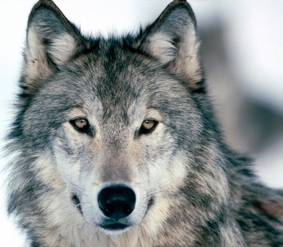
The allele ay is responsible for fawn or sable colour. In connection with this allele, 2 mutations c.246G>T (A82S) and c.250G>A (R83H) have been described (Berryere et al. 2005).
Example of fawn colour:
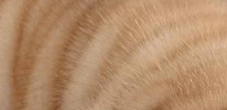
.
Example of sable colour:

.
The at allele produces a black to light brown, so-called black and tan (tricolour) phenotype.
Smooth and Rough Collies, Shetland Sheepdogs and other are typical adepts for locus A examination. There are two possible coat colors in these breeds: sable and tricolor. These colors can exists together or without merle coat color (merle increases risk of blindness and deafness!).
Genotypes of sable color:
- ayay
- ayat - tricolor carrier
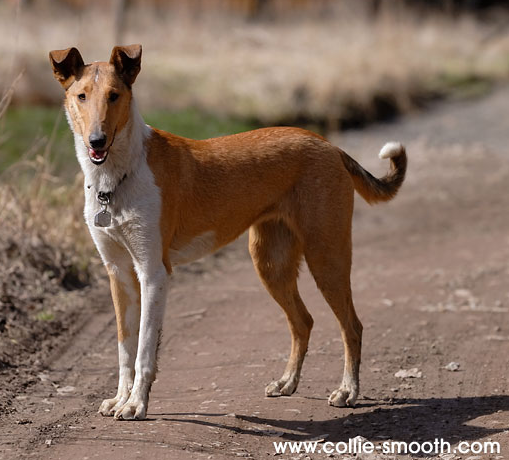
.
Genotypes of tricolor:
- atat
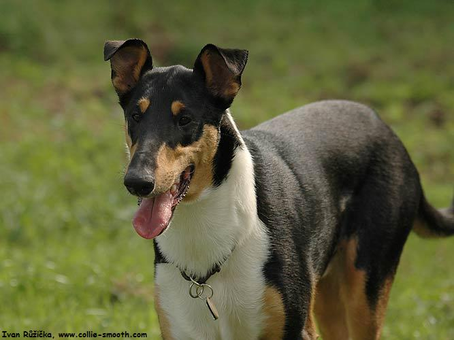
.
Merle coat color:
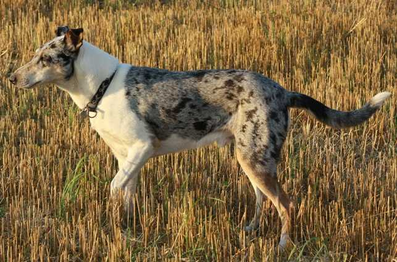
.
The A-locus test is suitable for the most dog breeds.
What is the relationship of A-locus A to E and K loci? Continue and have a look at the dominance hierarchy of allele affecting the coat colour in dogs.
.
References:
Berryere TG, Kerns JA, Barsh GS, Schmutz SM (2005) Association of an Agouti allele with fawn or sable coat color in domestic dogs. Mamm Genome 16, 262-72.
Kerns JA, Newton J, Berryere TG, Rubin EM, Cheng JF, Schmutz SM, Barsh GS. 2004. Characterization of the dog Agouti gene and a nonagouti mutation in German Shepherd Dogs. Mamm Genome. 15:798-808.
Schmutz SM, Berryere TG, Barta JL, Reddick KD, Schmutz JK (2007) Agouti seguence polymorphisms in coyotes, wolwes and dogs suggest hybridization. J Hered. 98(4):351-5. Epub 2007 Jul 13.
Dreger, Dayna L. and Schmutz, Sheila M. 2011. A SINE Insertion Causes the Black-and-Tan and Saddle Tan Phenotypes in Domestic Dogs. Journal of Heredity 2011 102: S11-S18



